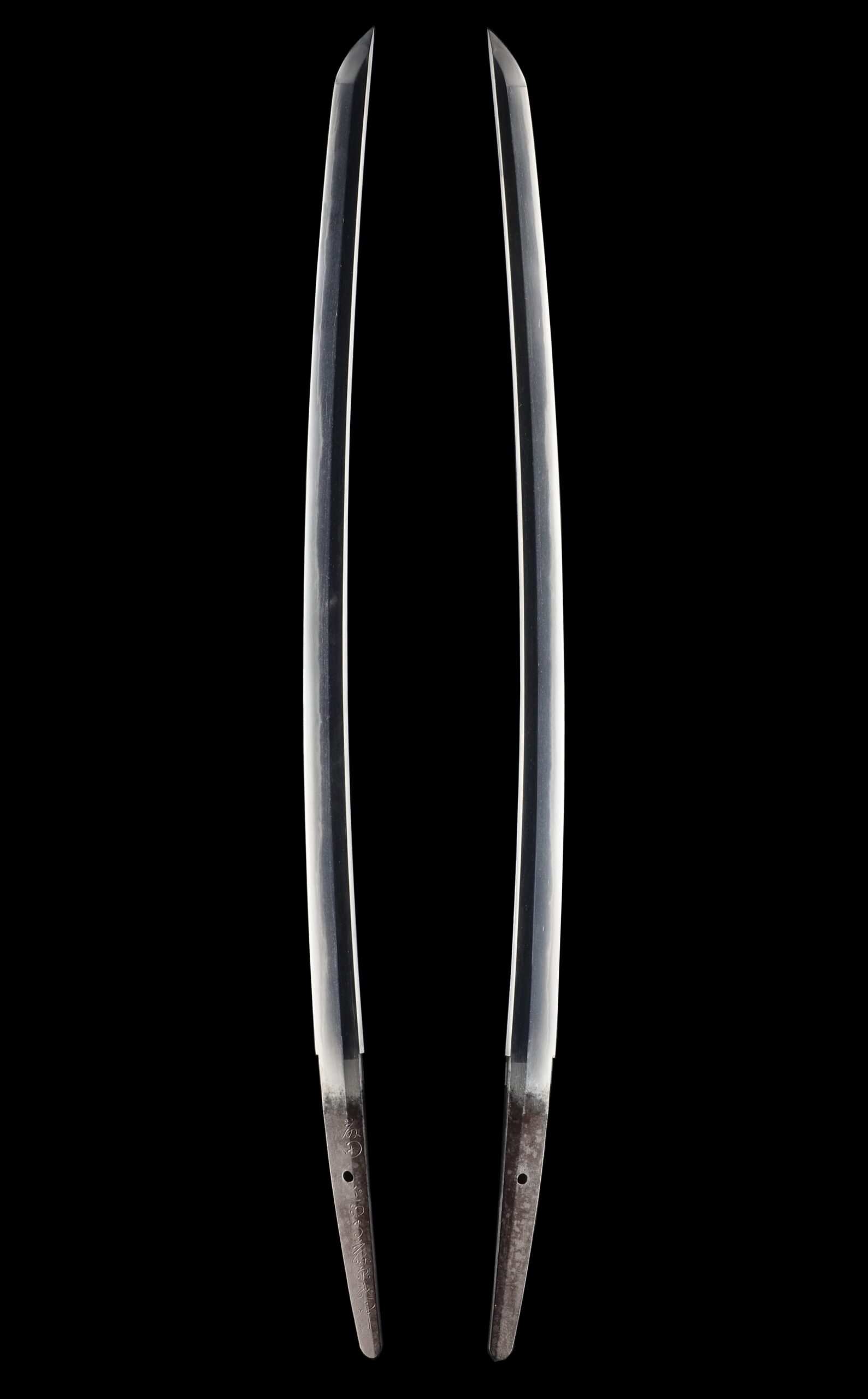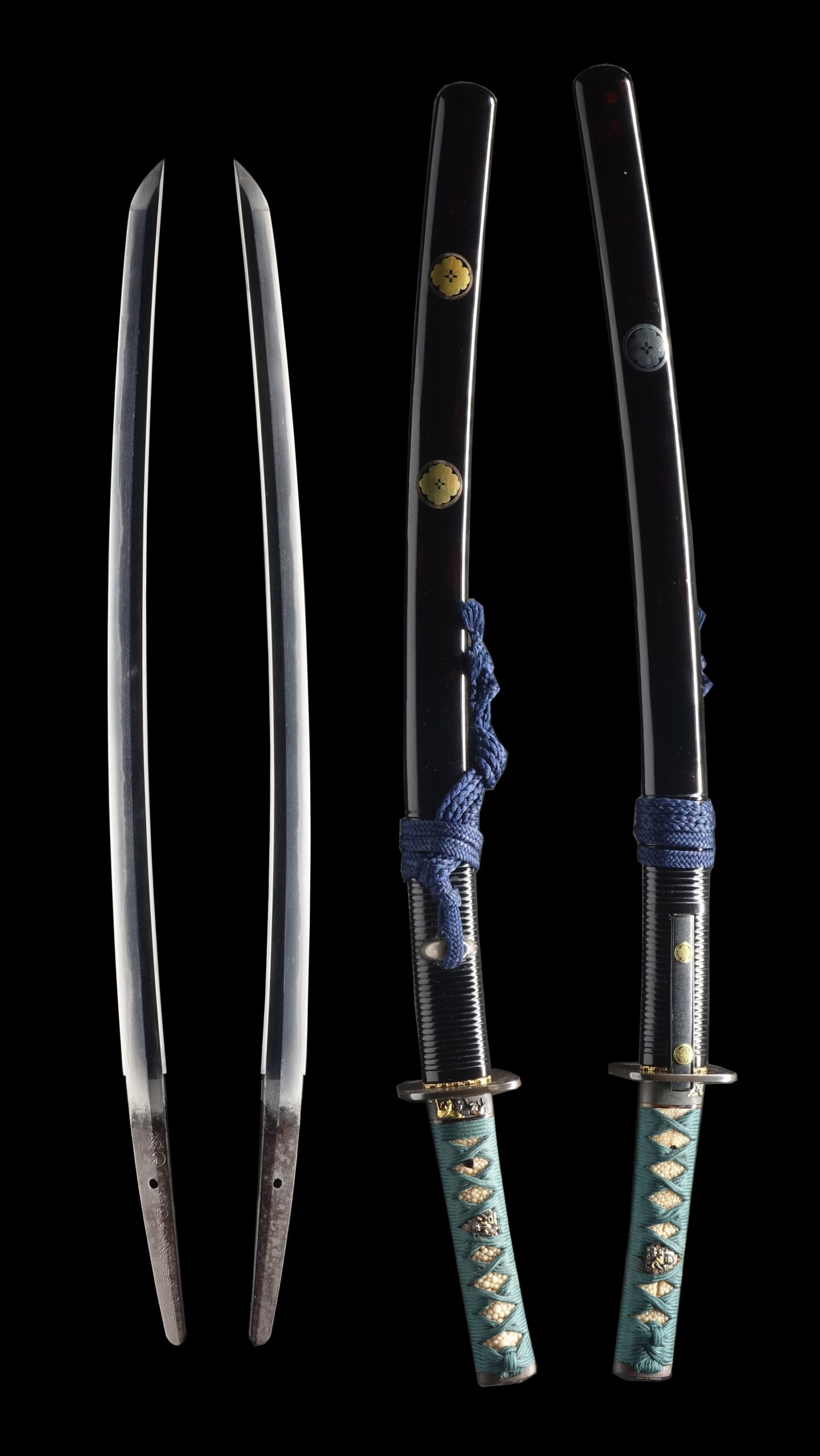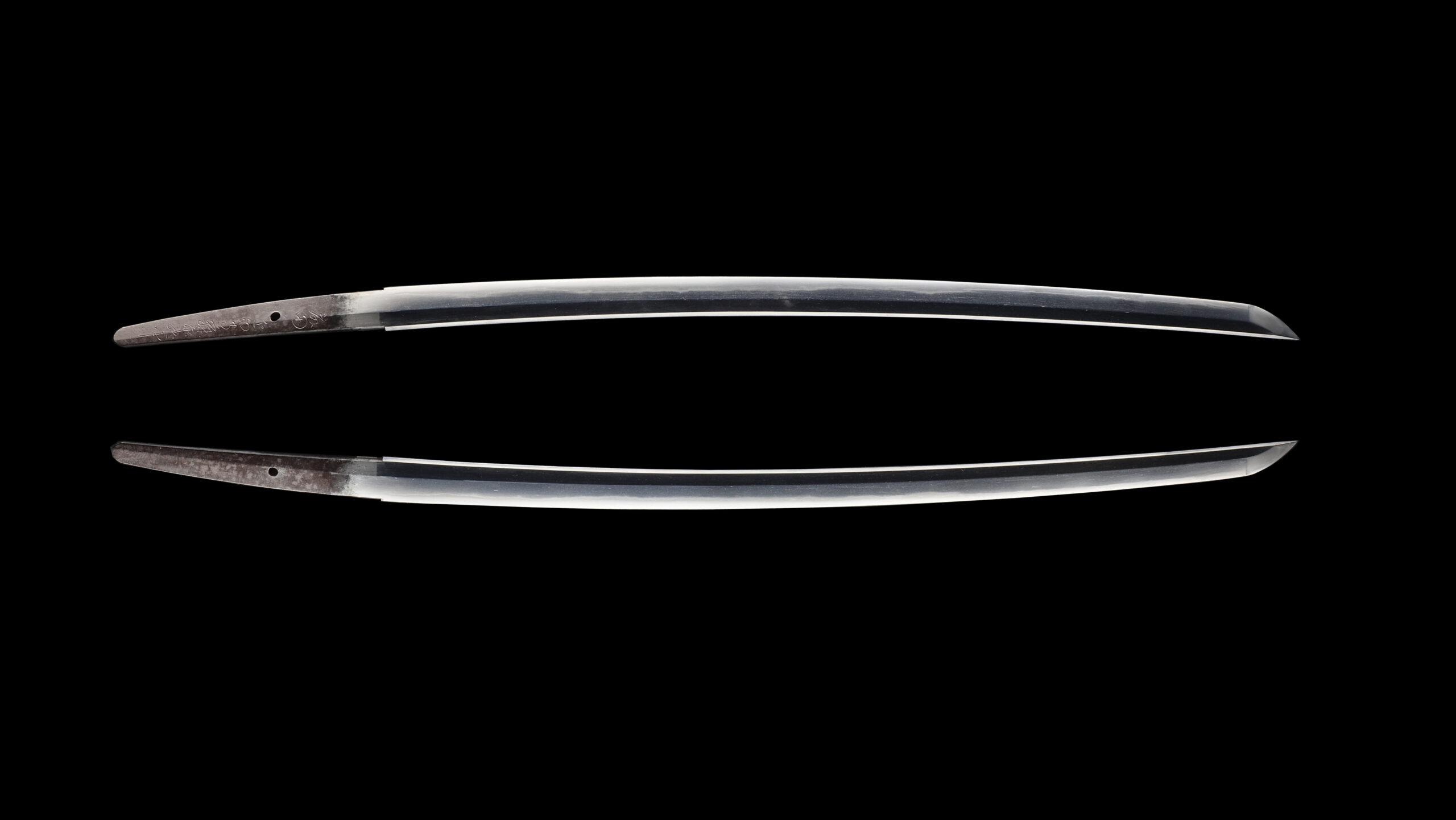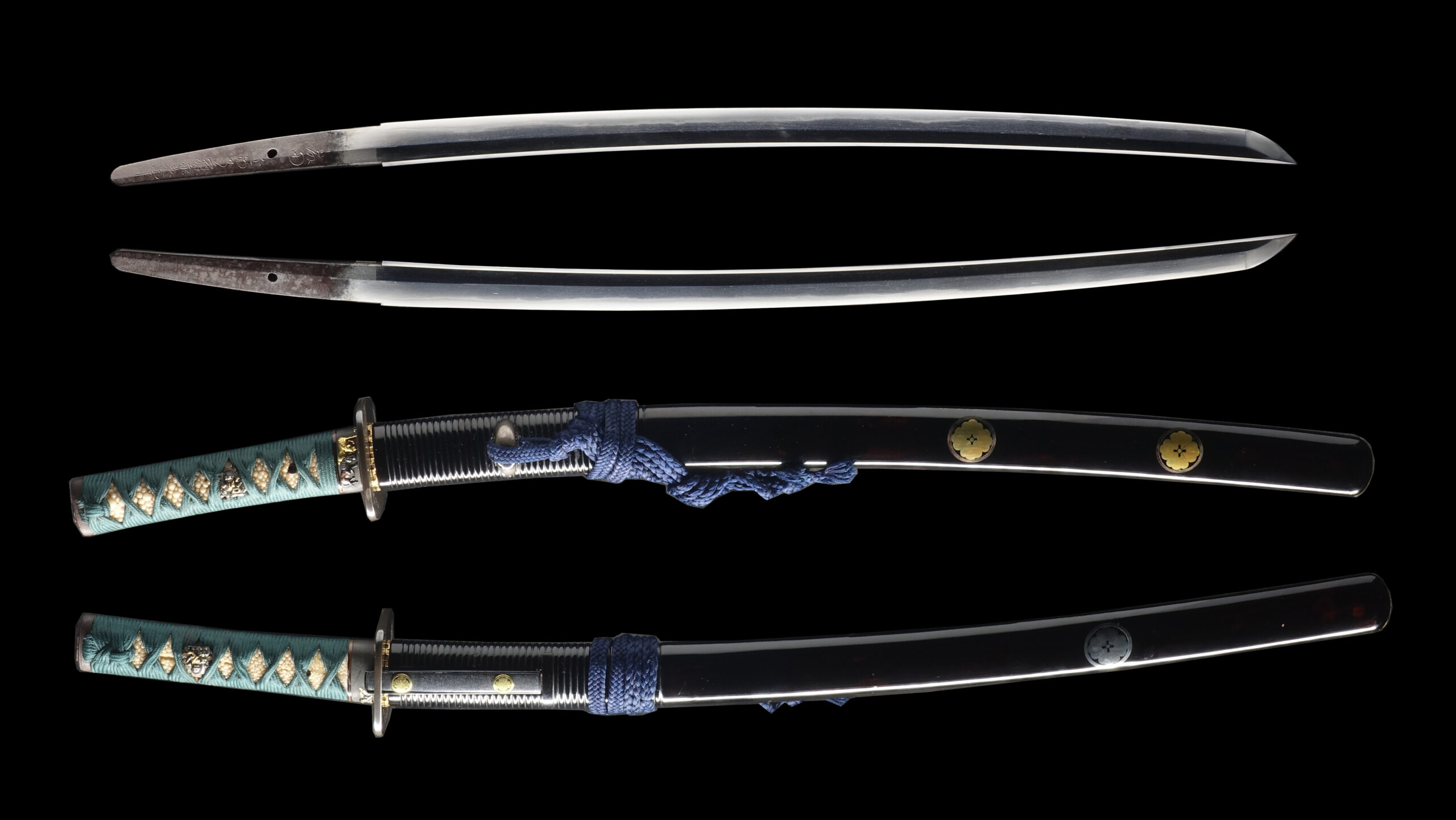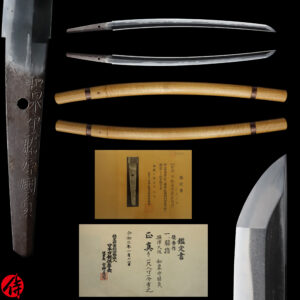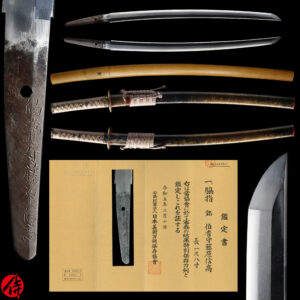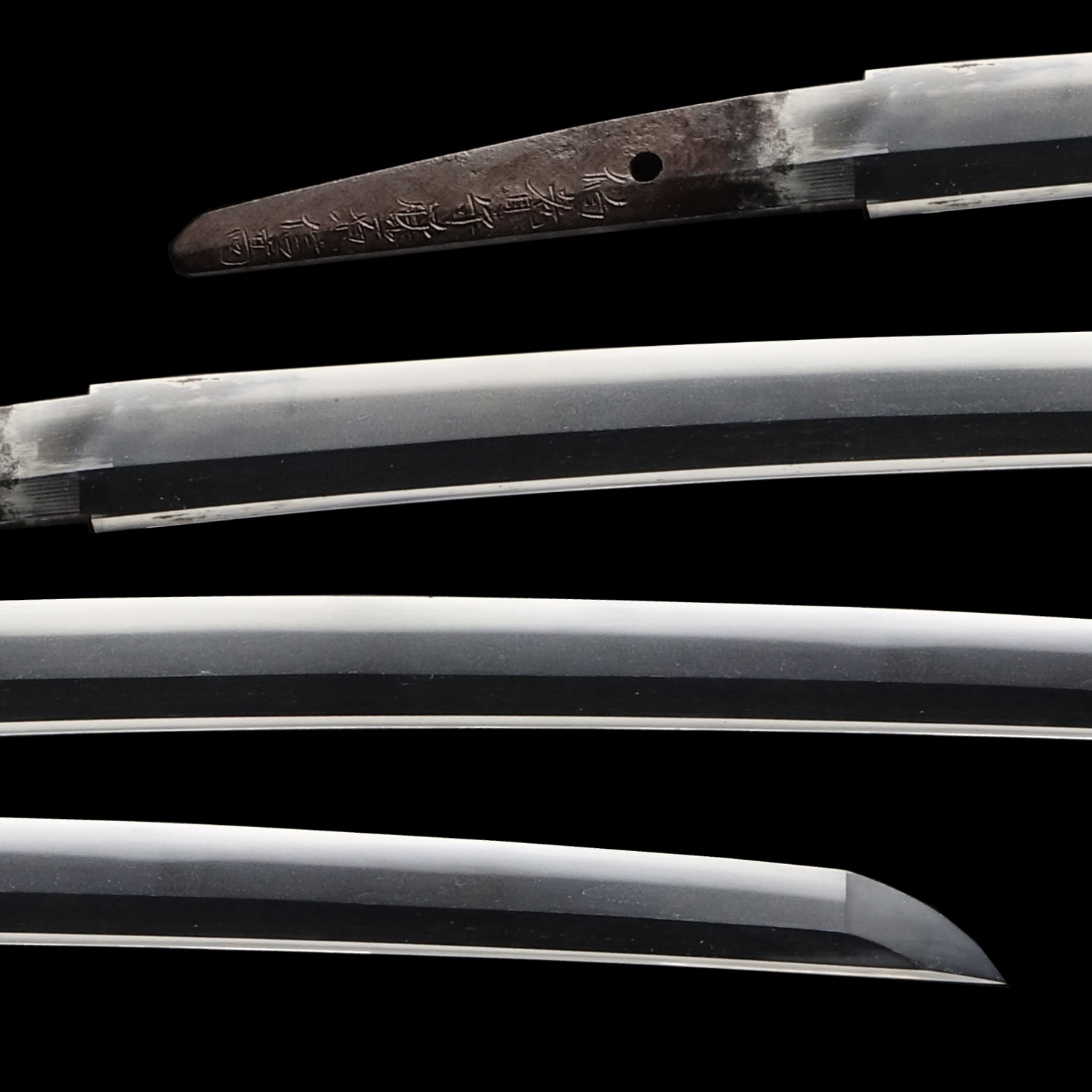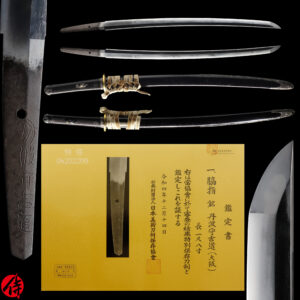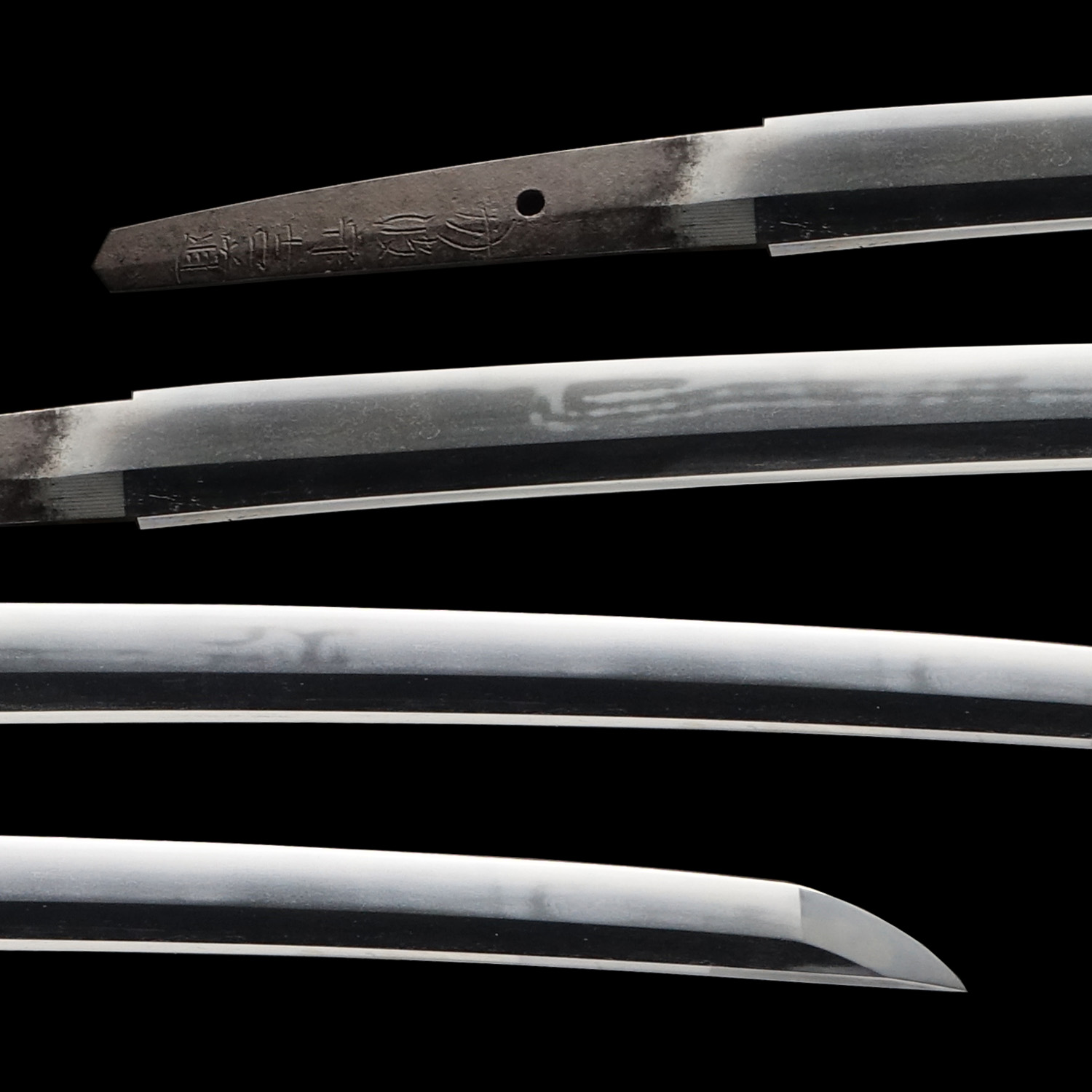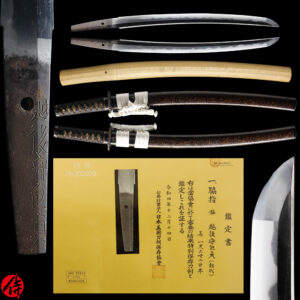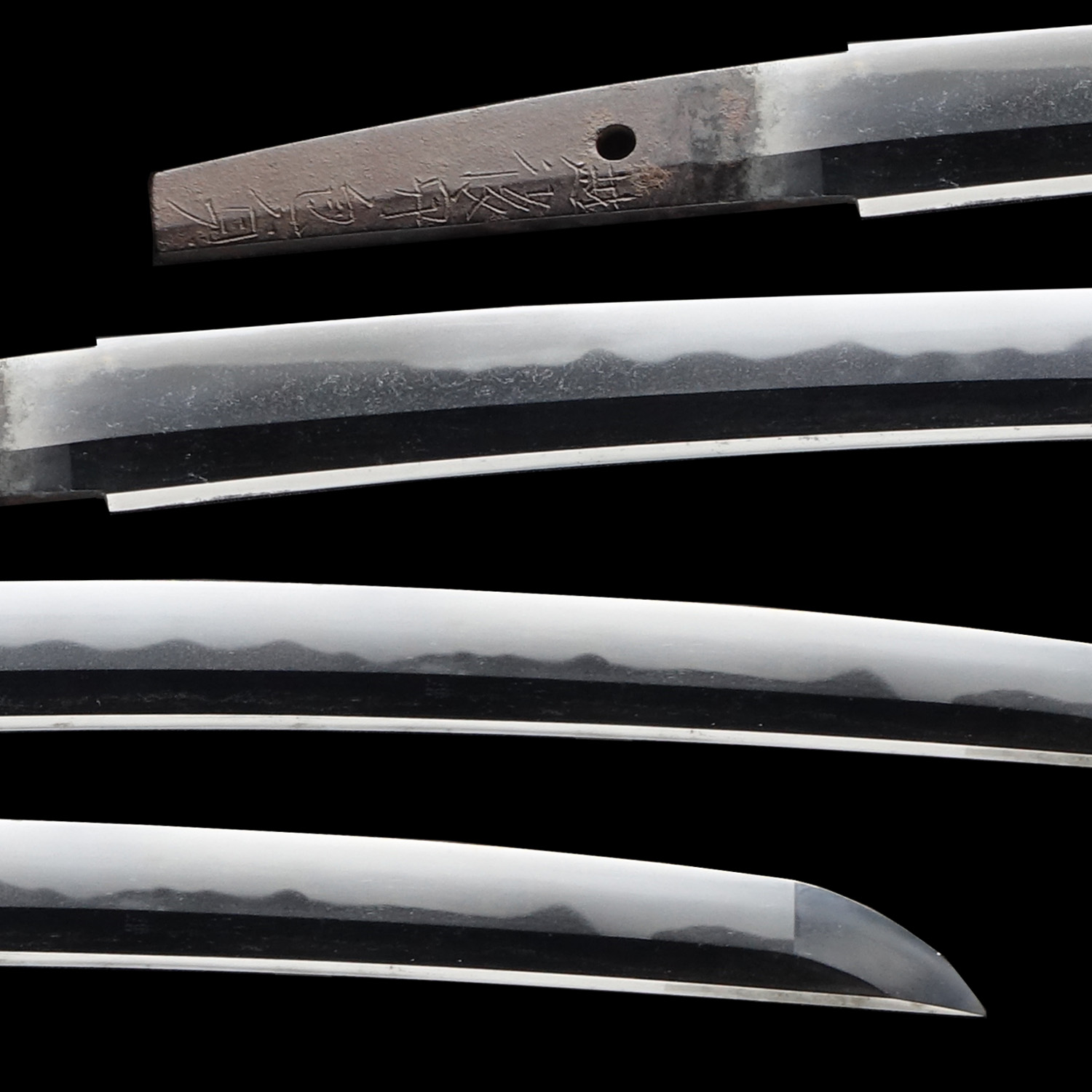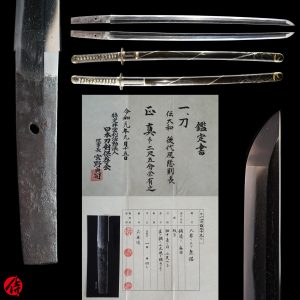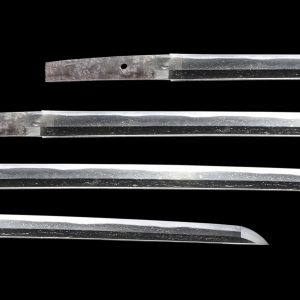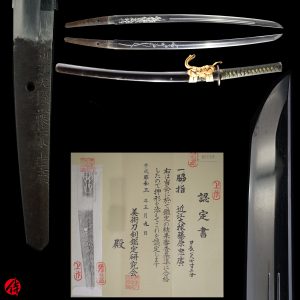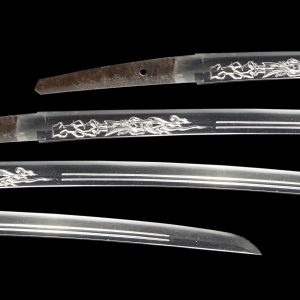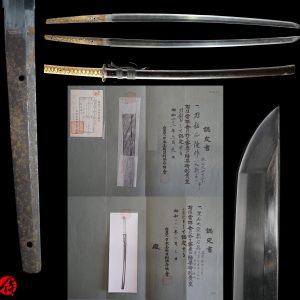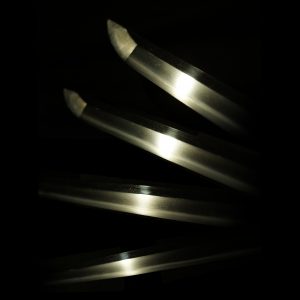Antique Japanese Sword Wakizashi Signed by Tsuguhira with NBTHK Tokubestsu Hozon Certificate
【Description】
Summary
This blade was signed by Fujita Omi no Kami Fujiwara Tsuguhira (藤田近江守藤原継平) during the An-Ei era (1772-1781: Late Edo Period), according to its NBTHK appraisal. The sword maker’s name, Tsuguhira, lasted six generations, and we believe the 4th-gen Tsuguhira forged this blade. The 4th-gen Tsuguhira learned great sword-forging techniques from his father, the third-gen Tsuguhira. The 4th-gen was especially active during 1748-1772 (Late Edo period).
The first-gen Omi no Kami Fujiwara Tsuguhira(近江守藤原継平) was an apprentice of the third-gen Echizen Yasutsugu(康継), and he belonged to Shimosaka school in Echizen province (today’s Fukui prefecture). He later moved to Edo City with his master.
Among the generations of Tsughira, the second-gen Tsuguhira was famous for having written a book called “Tsuguhira Oshigata,” in which he hand-traced swords stored and inherited among the Tokugawa shogun family for generations. He was allowed by the eighth Shogun, Tokugawa Yoshimune, to publish this book. This fact indicates that the second-gen Tsuguhira was a reputable swordsmith trusted by the Tokugawa Shogunate family.
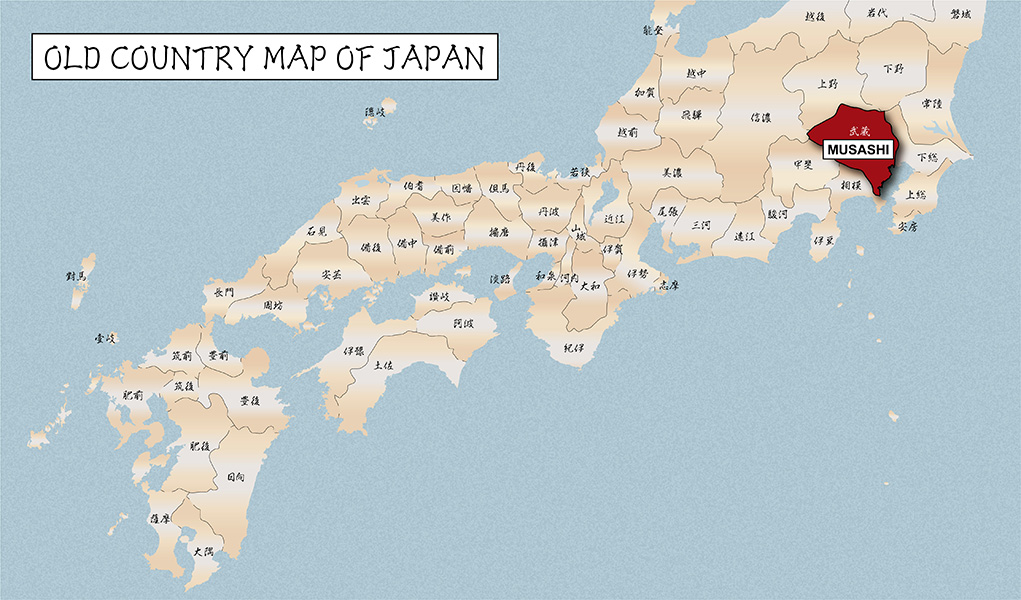
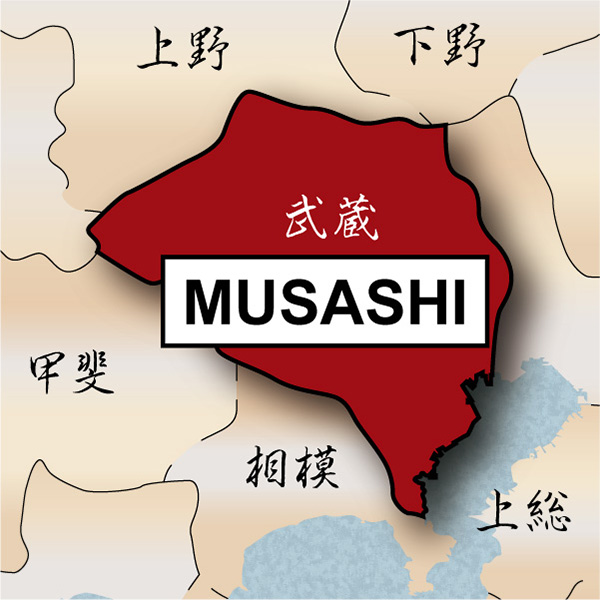
Echizen Shimosaka School
It is said that the first-gen Yasutsugu was the founder of the Echizen Shimoasaka school. He was born in Shimosaka town in Shiga prefecture at the end of the Muromachi period (Late 16 century ). He built his career there until the beginning of the Keicho era(1596). However, he moved to Echizen province due to the relocation of the lord he served. He eventually was noticed and supported by Matsudaira Hideyasu, the third son of Tokugawa Ieyasu, who was the founder of the Edo government.
Hideysu was the feudal lord of Echizen province during the early Edo period. With the support of Hideyasu, the first-gen Yasutsugu was able to establish the Echizen Shimosaka school. And his school’s fame became nationwide. By Hideyasu’s recommendation, the first-gen Yasutsugu became Okakaekaji for the Tokugawa shogun family, meaning that he exclusively forged swords for the Shogun family. Yasutsu was acknowledged by the first and second Tokugawa Shoguns, Tokugawa Ieyasu, and Tokugawa Hidetada.
The first-gen Yasutsugu received 康(YASU) from Tokugawa Ieyasu and changed his maker’s name. He was also allowed to inscribe the holly oak symbol(family crest of Tokugawa) on the tang. The school flourished during the Edo period and trained many skilled apprentices. We believe Kanenori mastered a superb level of craftsmanship by belonging to this school.
Echizen province was prosperous during the Edo period, being ruled by the Echizen Matsudaira clan, a direct retainer of Tokugawa clan who ruled the Edo government. Many skilled swordsmiths moved to Echizen from different regions because of high demand among Samurai who lived there. Among them, there were many renowned swordsmiths who were originally from the Mino province (Gifu prefecture). They are called Echizen Seki swordsmiths.
This blade is appraised as a Tokubetsu Hozon Token(特別保存刀剣) issued by NBTHK(Nihon Bijutsu Touken Hozon Kyokai:日本美術刀剣保存協会). This authentication paper was only given to authentic Japanese swords, especially well preserved and high quality with artistic value.
【Blade】
Cutting Edge Length(Nagasa): 53.8 cm ( 21.2 inches)
Curvature(Sori):1.21 cm (0.47 inches)

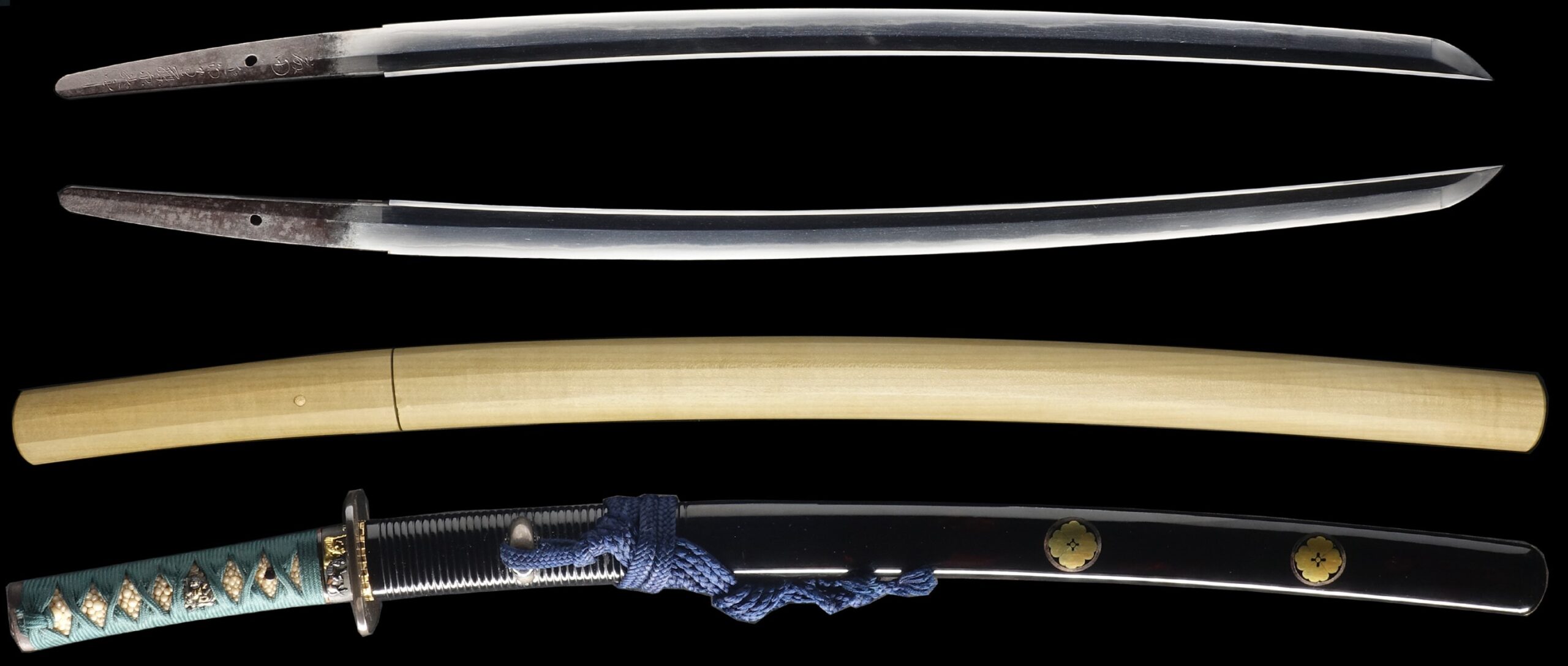
Hamon:
The crystalline structure which forms along the cutting edge of a blade as a result of the hardening process
Jimon(Jihada):
visible steel surface pattern created by folding and hammering during forging process
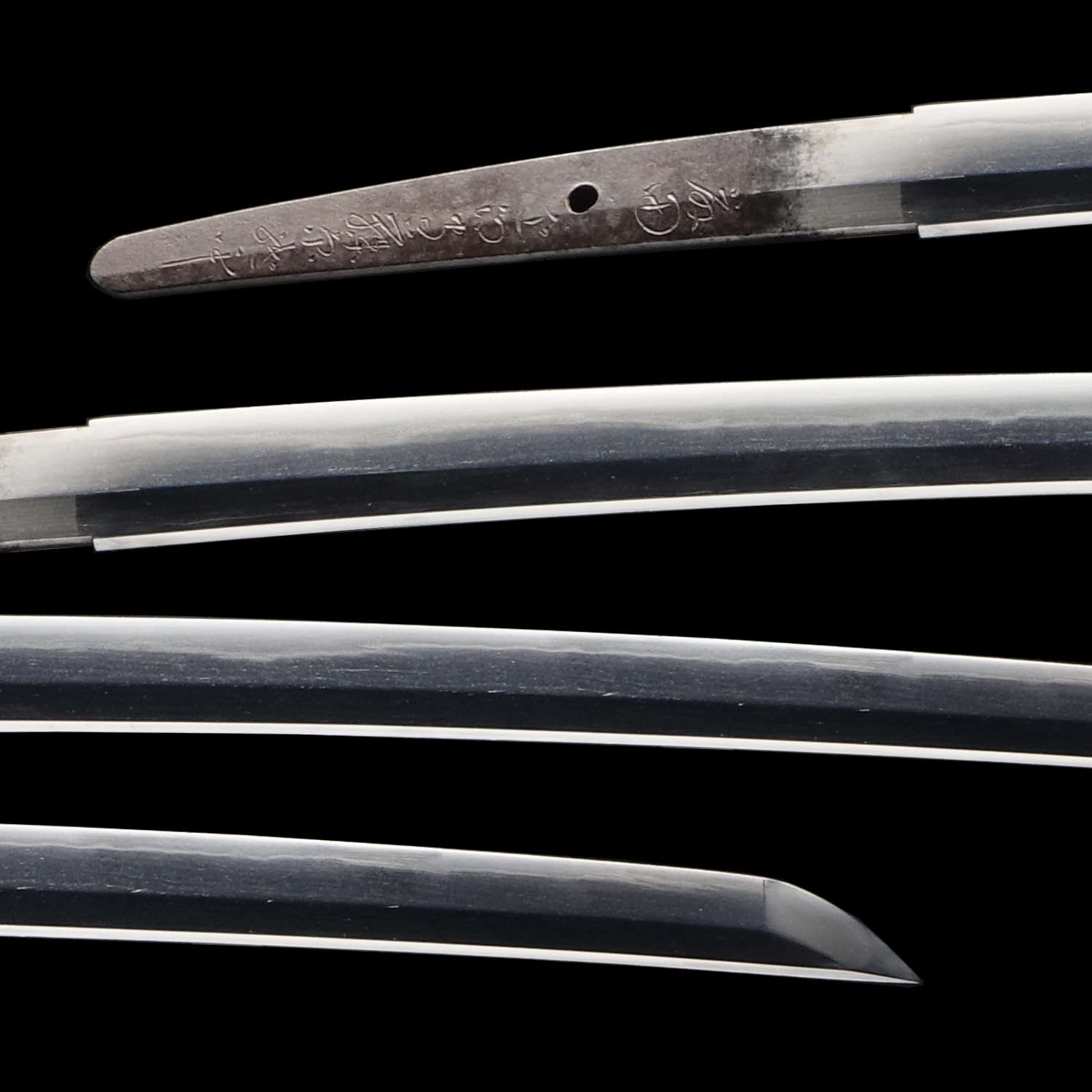
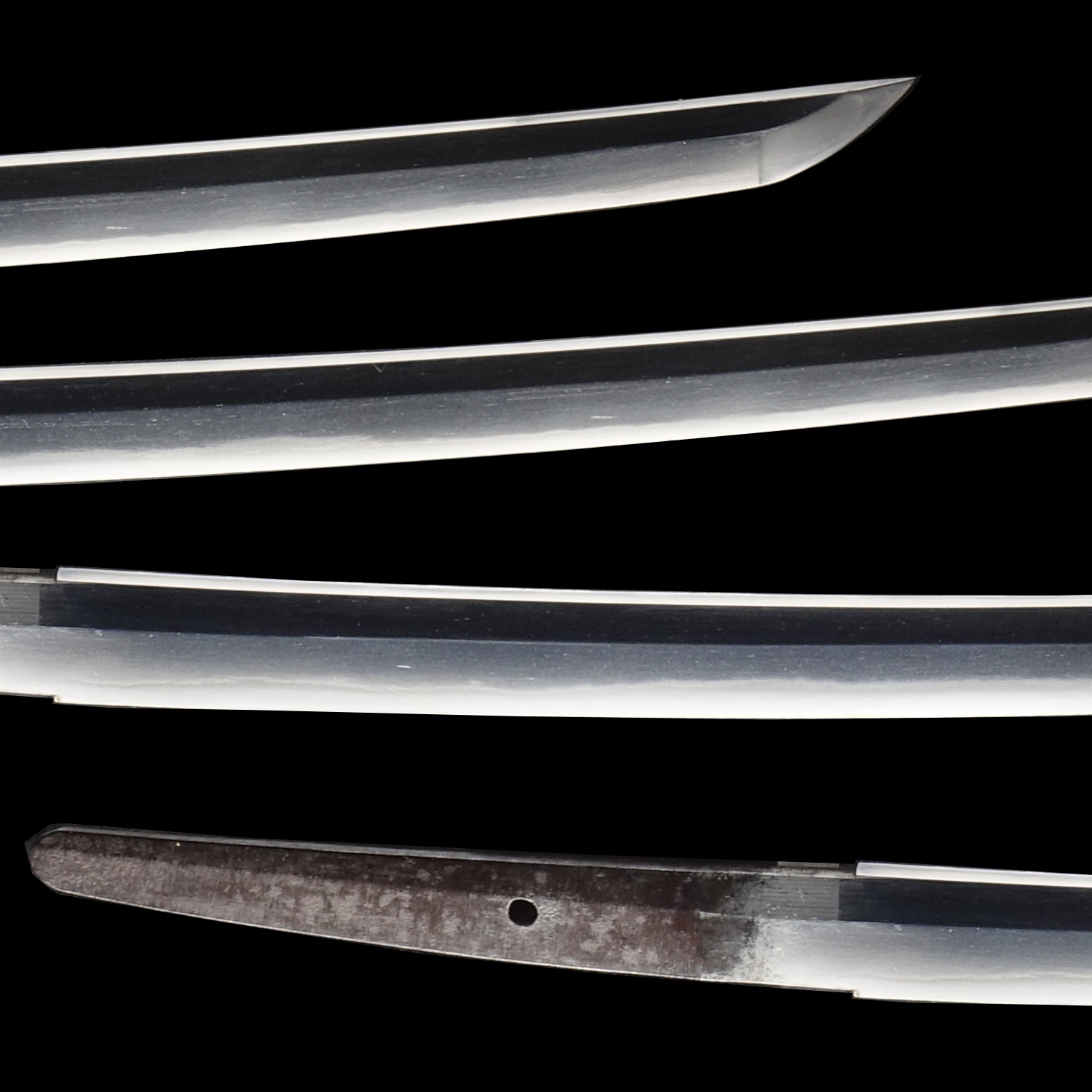
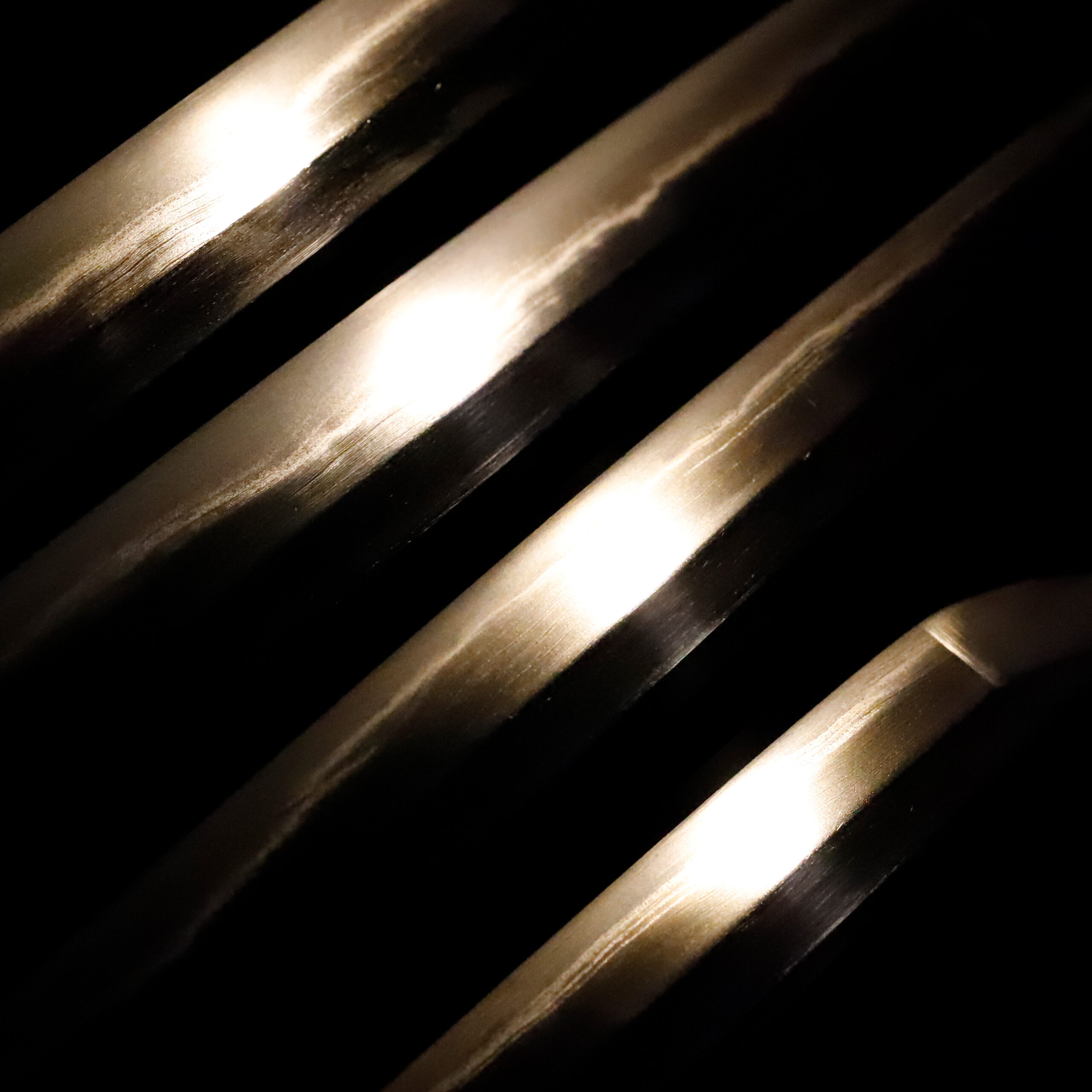
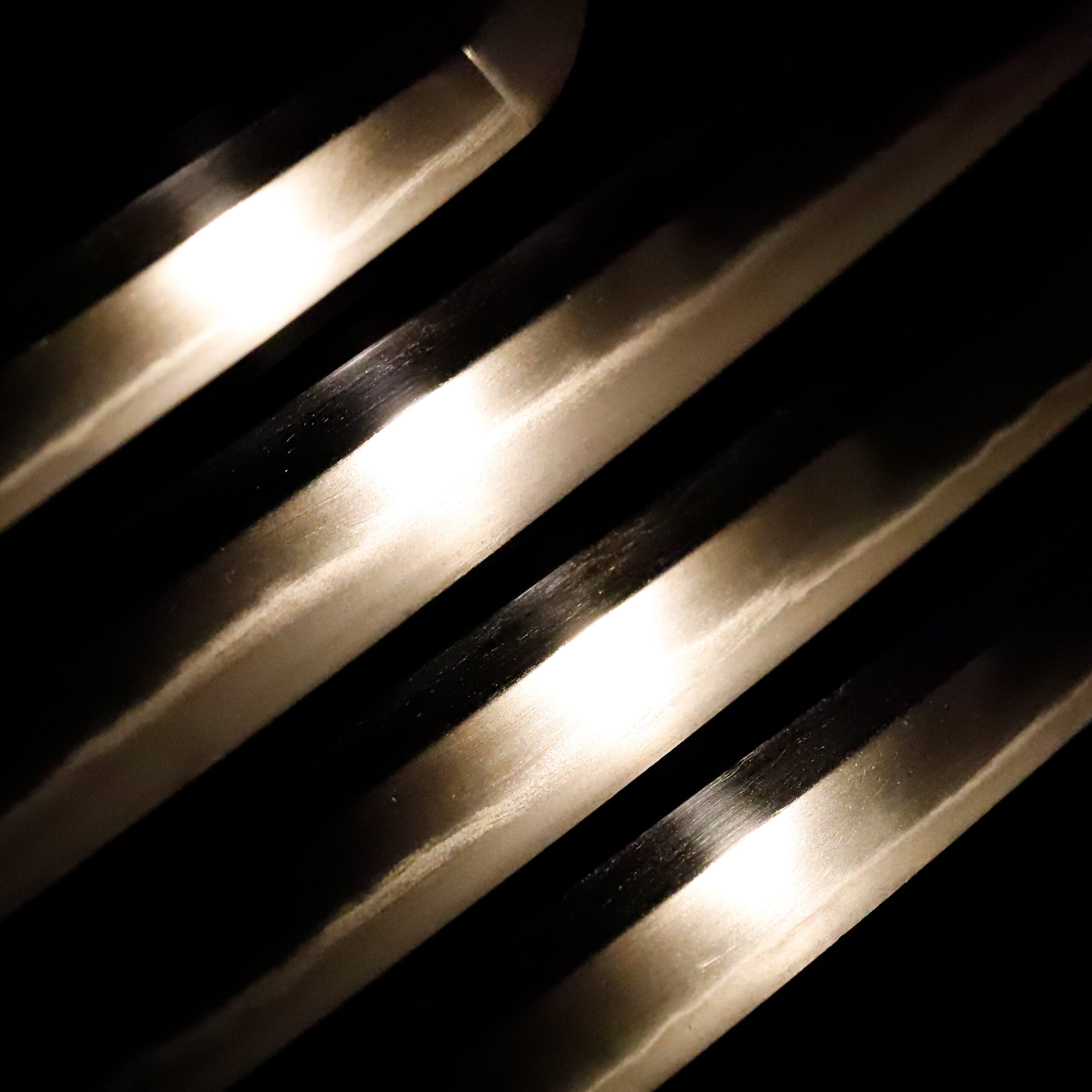
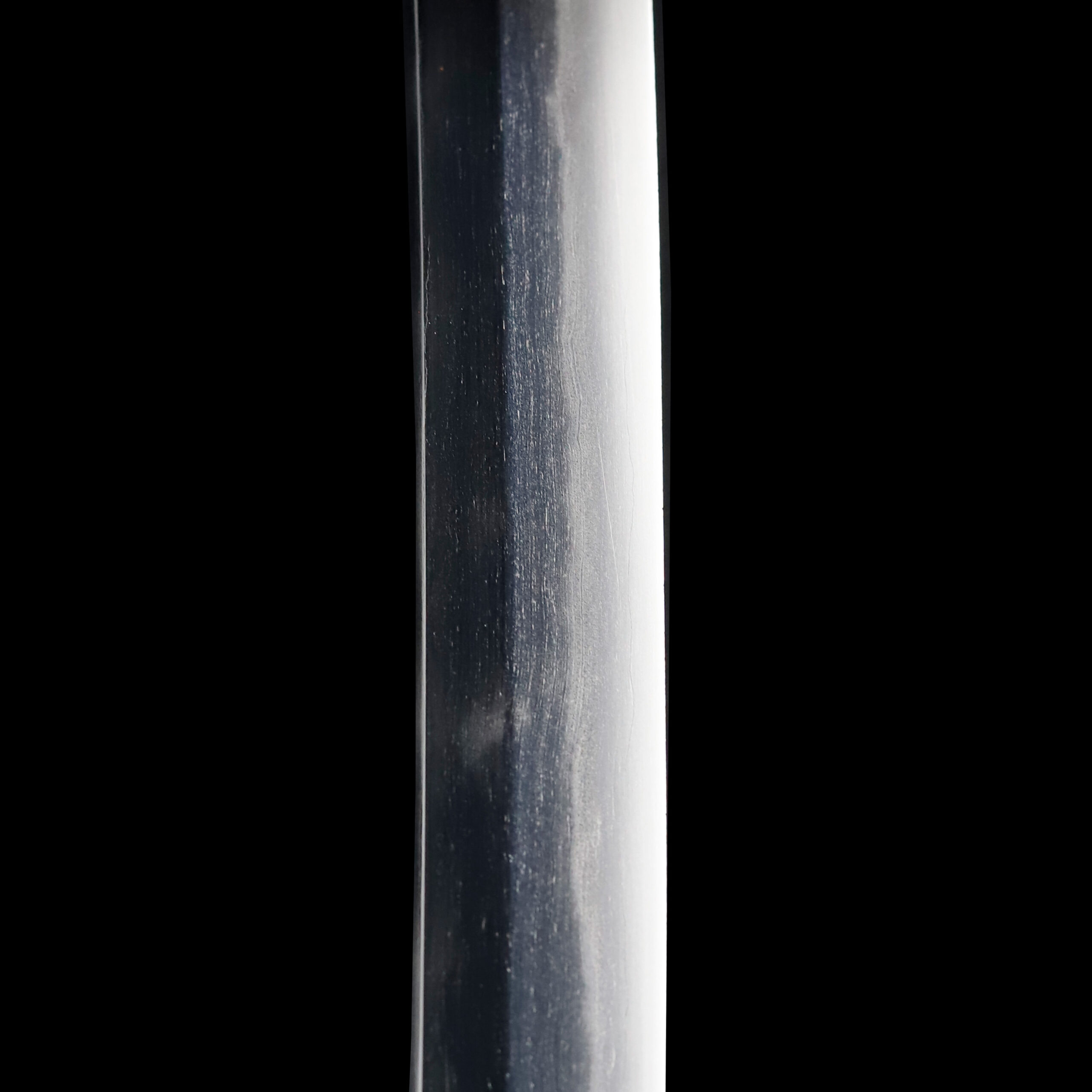
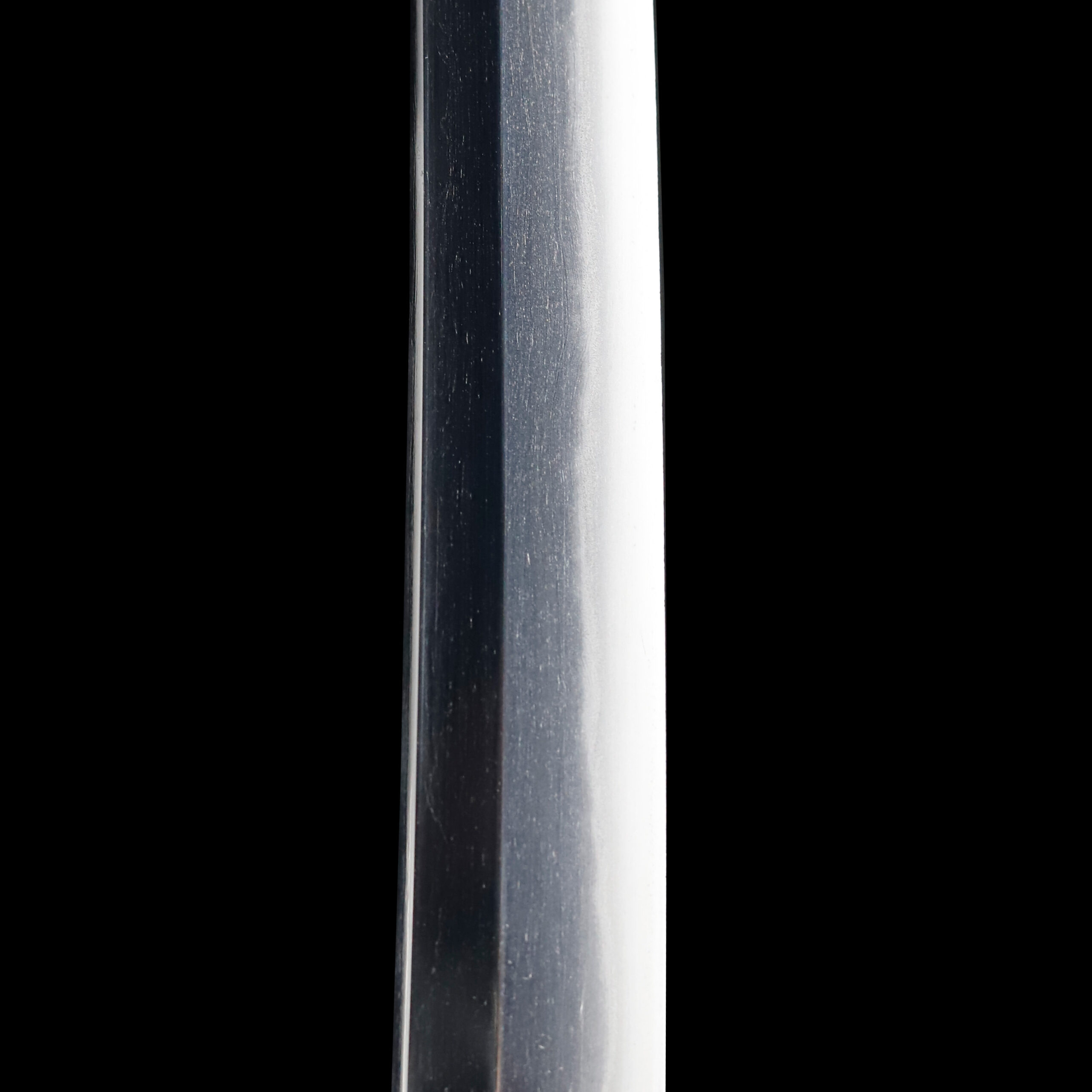
Nakago:Nakago is the tang of the Japanese sword.
Japanese swordsmiths left the black rust on the tang because it prevents red rust while the tang is in its handle. And the discoloration of the tang was created over time, and it is a great indicator for a Japanese sword specialist to estimate when the sword was forged.

Koshirae: Koshirae is the mounting of the Japanese sword. There are several parts that consist of Koshirae such as Saya(Scabbard), Tsuka( Handle), Tsuba(Handguard).
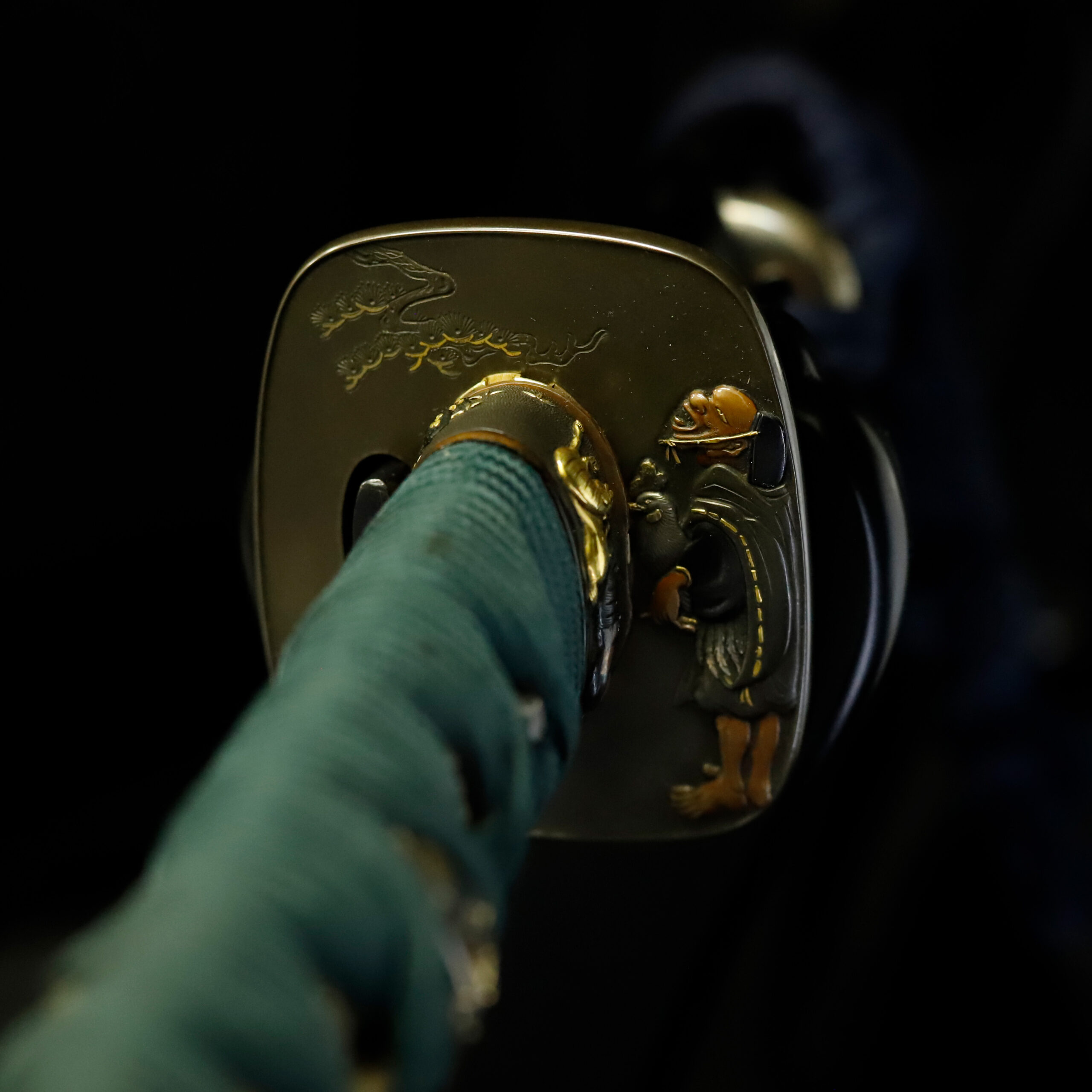
Fuchi-Kashira:A pair of matching sword fittings that cover the upper and bottom parts of its sword hilt.
Horses are engraved on this Fuchi Kashira. While some parts are rusty due to age, we could find two horses on each Fuchi and Kashira part. In Japan, horses were thought of as vehicles for gods to be dedicated to shrines in ancient times. There are various horse designs. Among them, there is a design that composed of nine horses. In Japanese, there are horse-related words “馬九行久” and “馬九行駆.” Both these words are pronounced as Umakuiku (うまくいく). Uma (馬) is a horse, and Umakuiku itself means everything will go well. If we interpret the string of characters listed in Kanji (漢字) in a dictionary sense, it means that nine horses are going. However, it has long been said that the design combining nine horses brings the following nine fortunes: game luck, financial luck, career luck, family luck, love luck, health luck, prosperous business, plentiful harvest, and exam pass.
We would also like to talk about horses from the perspective of samurai culture. Horses had been used as a tool for rituals and festivals. After the age of the Samurai warriors appeared, wearing large armor or performing archery and riding a hose became martial arts. Equestrian tactics became the pillar of military action and security activities. According to a theory, that is the reason that the Japanese sword began to have a curve to make it suitable for slashing (the Japanese sword was straight in the beginning).
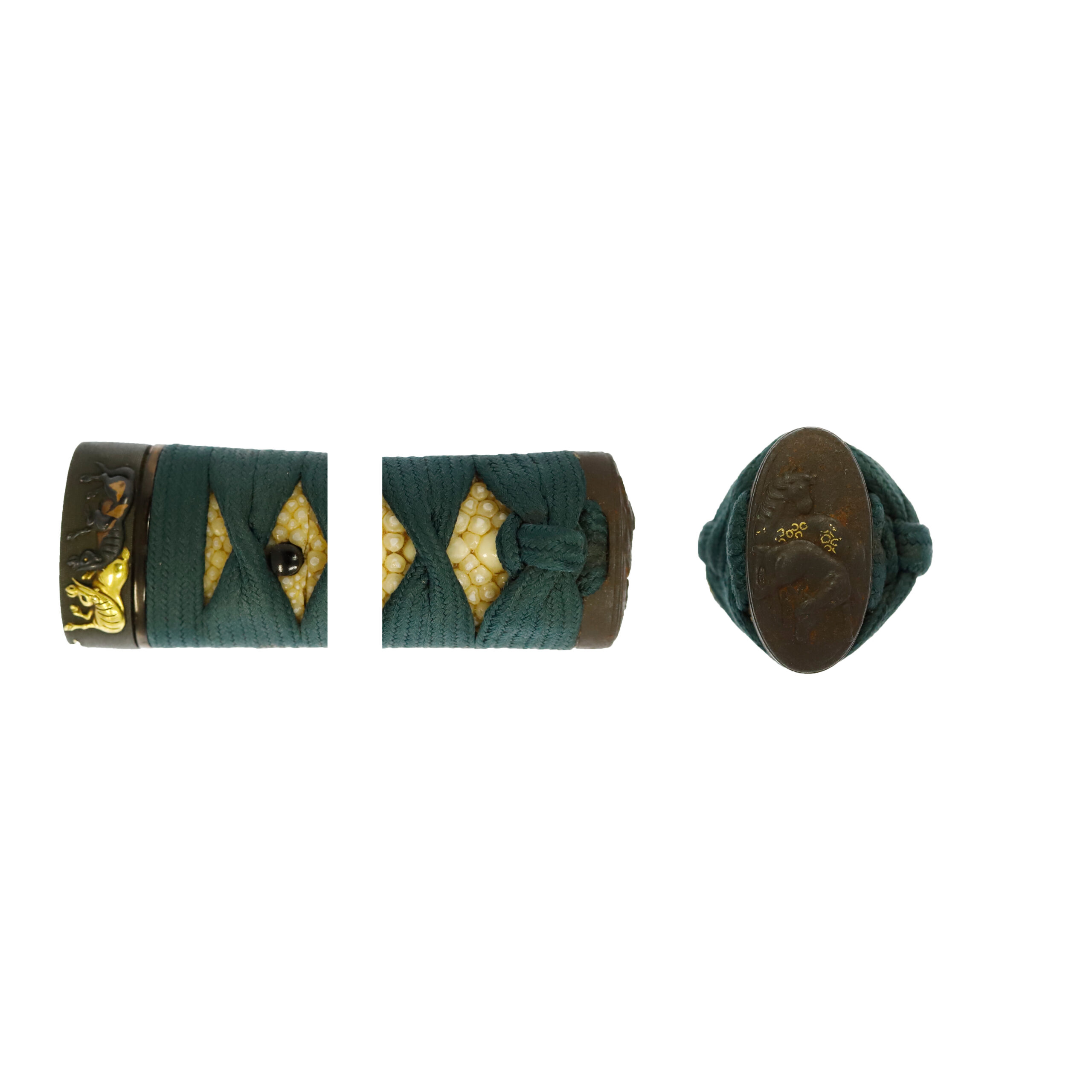
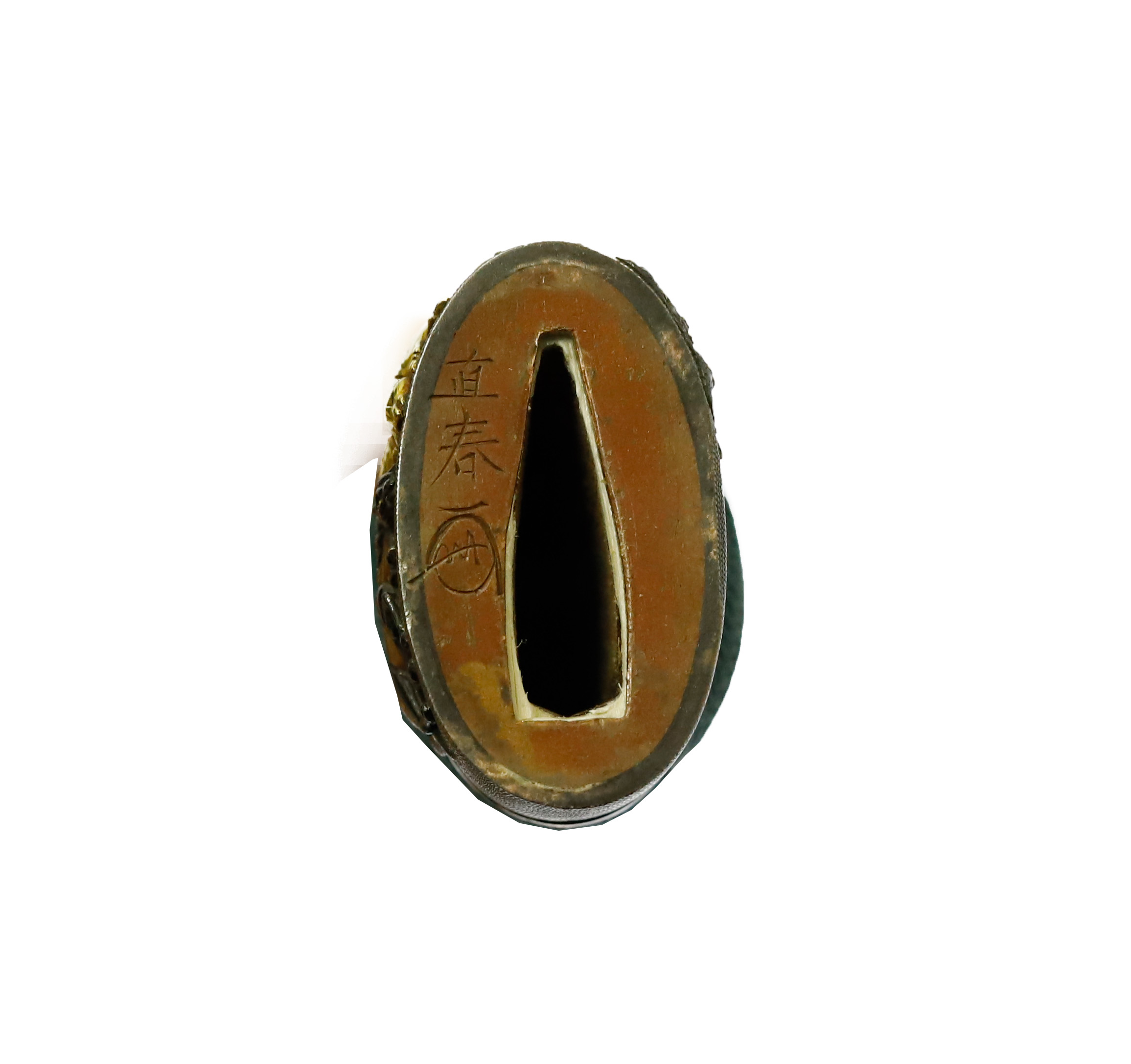
Tsuka and Menuki:Tsuka is the handle of the Japanese sword and Menuki is its decoration.
We assume the model of this Menuki is the Fudo Myo-O (不動明王, acalanātha). Gold and silvery paints are effectively applied to some parts. He is one of the objects of worship in Buddhism. According to a theory, it is the incarnation of Dainichi Nyorai (大日如来, Mahāvairocana, the principal image of esoteric Buddhism). He is making a brave appearance to save the unsalvageable who are covered in worldly desires and to cut off the evil hearts that obstruct the path of Buddhism. Fudo Myo-O holds the Kurikara-ken (倶利伽羅剣) in his right hand. This blade was named after its appearance that Kurikara Ryu-O (倶利伽羅龍王, dragon) is winding around the sword. It is believed Kurikara-Ken could cut off worldly desires: Sandoku (三毒). Sandoku is the three fundamental human desires: Ton (貪, greed), Jin (瞋, anger, grudge), and Chi (癡, delusion, complaint).
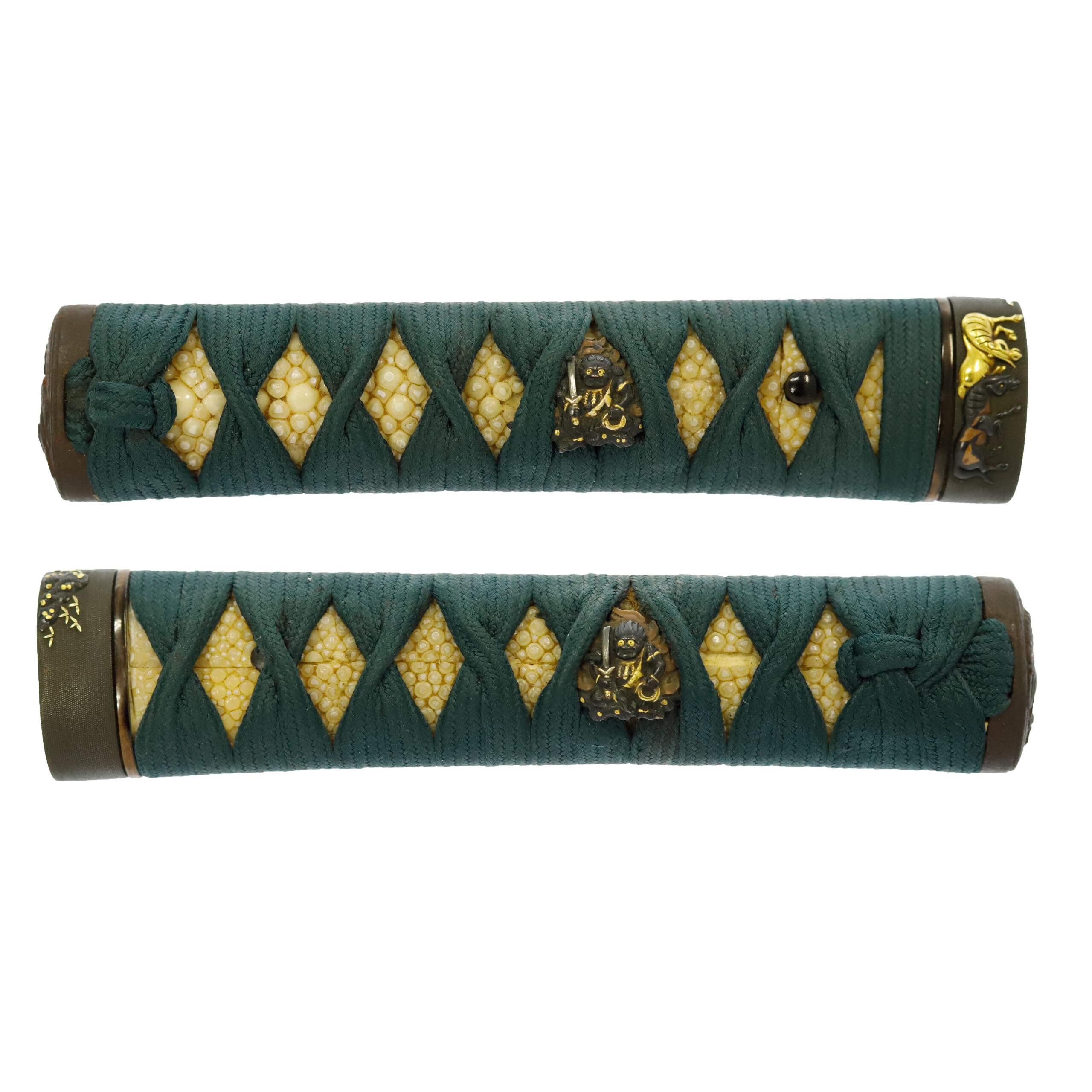
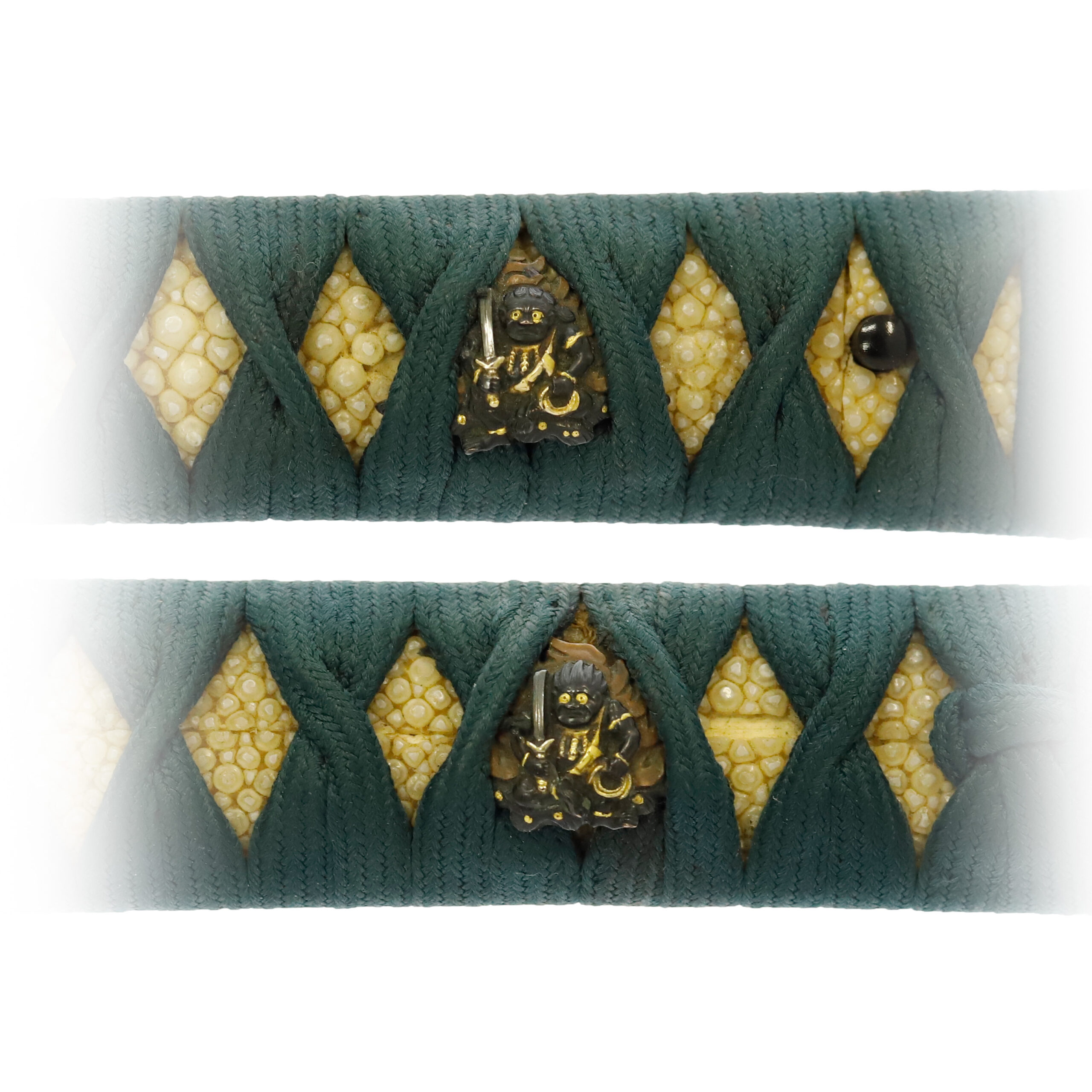
Tsuba and Habaki:Tsuba is the handguard for the Japanese Sword and Habaki is the equipment to make the blade not touch its scabbard inside. It prevents the blade from getting rusty and chipped.
It depicts a man holding a chicken and looking up at the sky with his mouth wide open and another chicken standing beside him. It is unknown who this person is and what this scene represents. It might show a scene quoted from some story or story. The detailed carvings throughout demonstrate the maker’s skilled technique.

Kozuka:Kozuka is a small knife stored in Kozuka Hitsu(groove of the sheath of the Japanese sword).
A Kogatana (小刀, small knife) is stored in the Kozuka. Sutra-like text is engraved on the blade. The same golden family crests are applied to the Kozuka. This family crest is called the Maru-ni Hanabishi Mon (丸に花菱紋). It is also designed on the scabbard. Petals are designed in a rhombus. This pattern became a Yusoku Monyou (有職文様, a generic term for designs of court nobles’ clothing or furnishings; these designs have unique and elegant styles) during the Heian period (794-1185). And people loved it as an auspicious pattern.
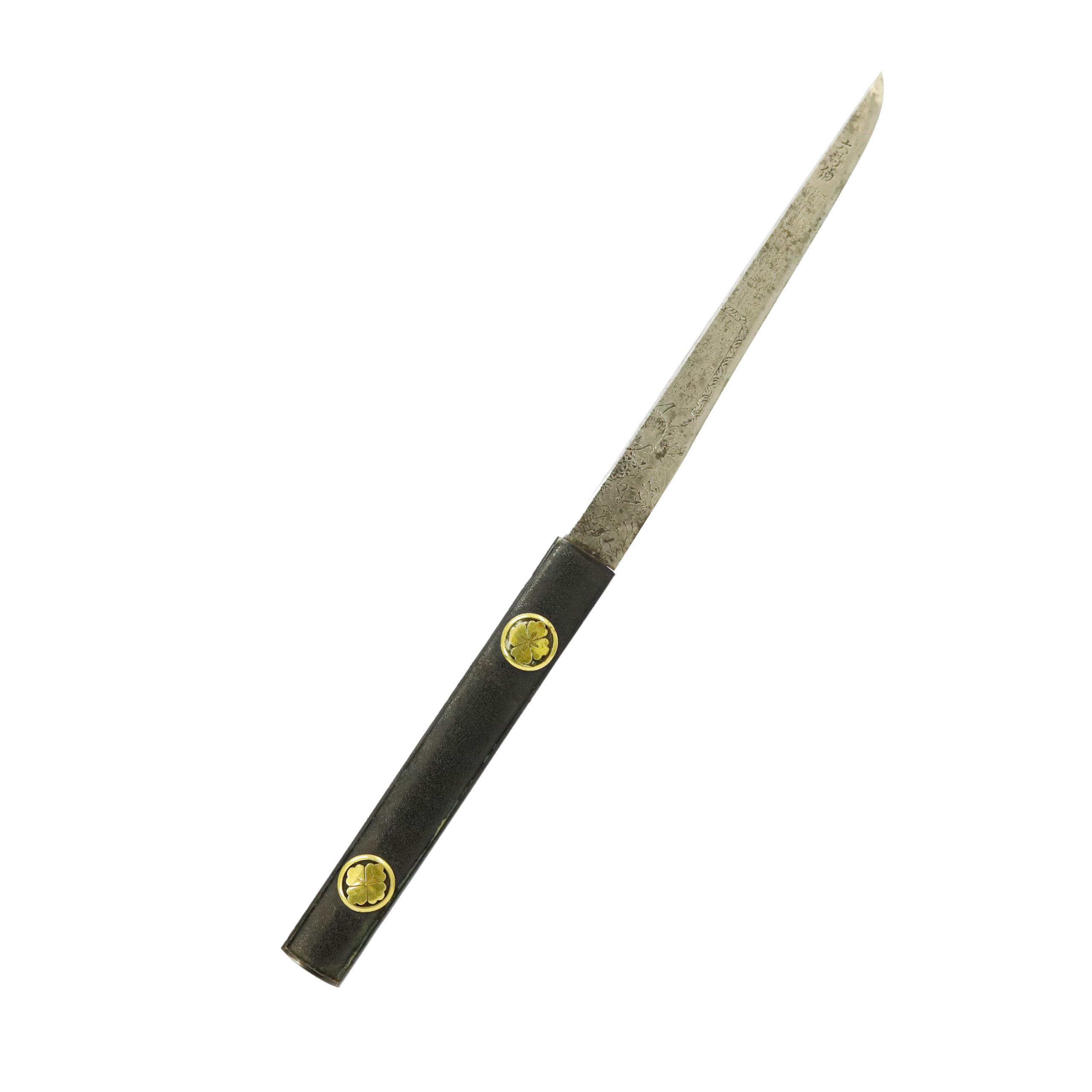
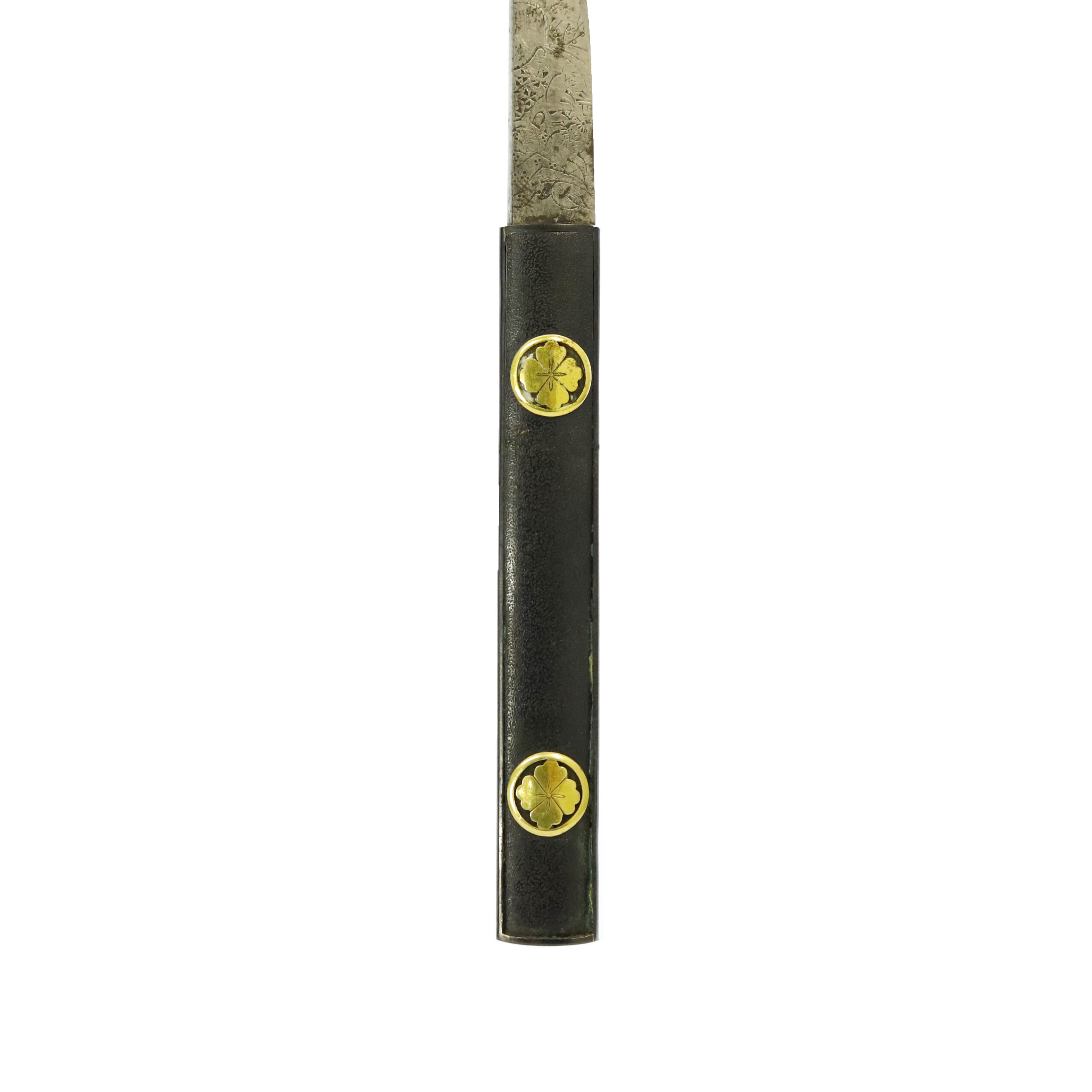
Saya: Saya is the scabbard for the Japanese sword.

Authentication Paper:NBTHK Tokubetsu Hozon Certificate for the blade (No. 1015140)
NBTHK, also known as Nihon Bijutsu Touken Hozon Kyokai (the Society for the Preservation of the Japan Art Sword), is one of the oldest Japanese sword appraising organizations in modern-day Japan. They authenticated the blade on Feb 25th in the third year of Reiwa (2021). They appraised it as Tokubetsu Hozon Touken, the blade especially worth preserving for Japanese society. The purchaser will receive this original certificate as well. We can also translate what is written into English and make a PDF file for your record if you request.
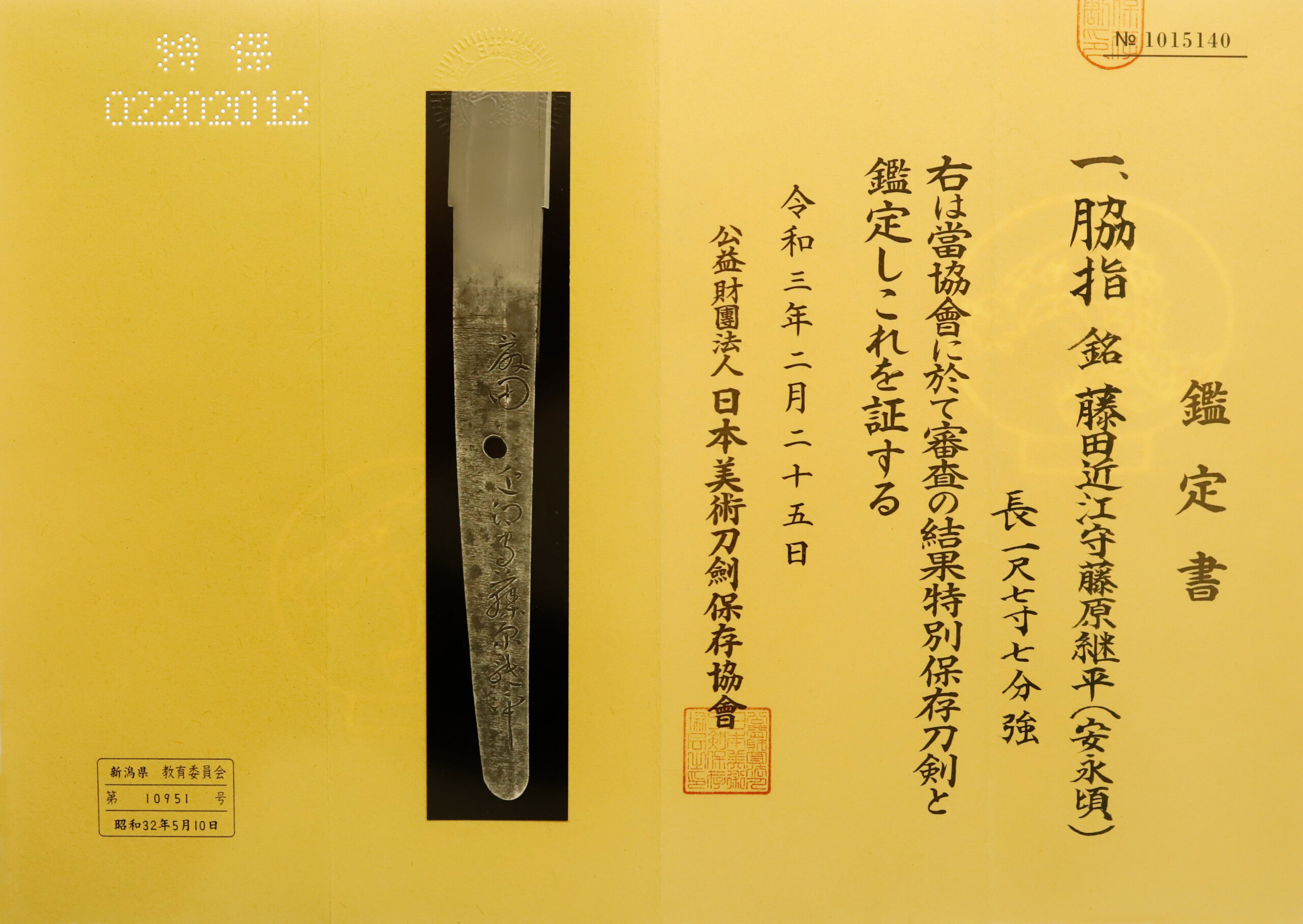
Registration Number : Niigata 10951
The Board of Education in Niigata prefecture issued a registration paper for this sword. It is called Jyu Token Rui Torokusho(銃刀剣類登録証). Bunkacho(The Agency for Cultural Affairs) acknowledges a Japanese sword with this paper as a work of art.
The sword needs to be traditionally hand-forged and made of Tamahagane carbon steel to be registered in the system. With this paper, its owner in Japan can legally own an authentic Japanese sword. Based on this registration number, we will apply for its export permit.
This paper will need to be returned to the board of education when the sword is being shipped abroad, but you can receive a copy of it. An English translation of this registration paper is available on request.
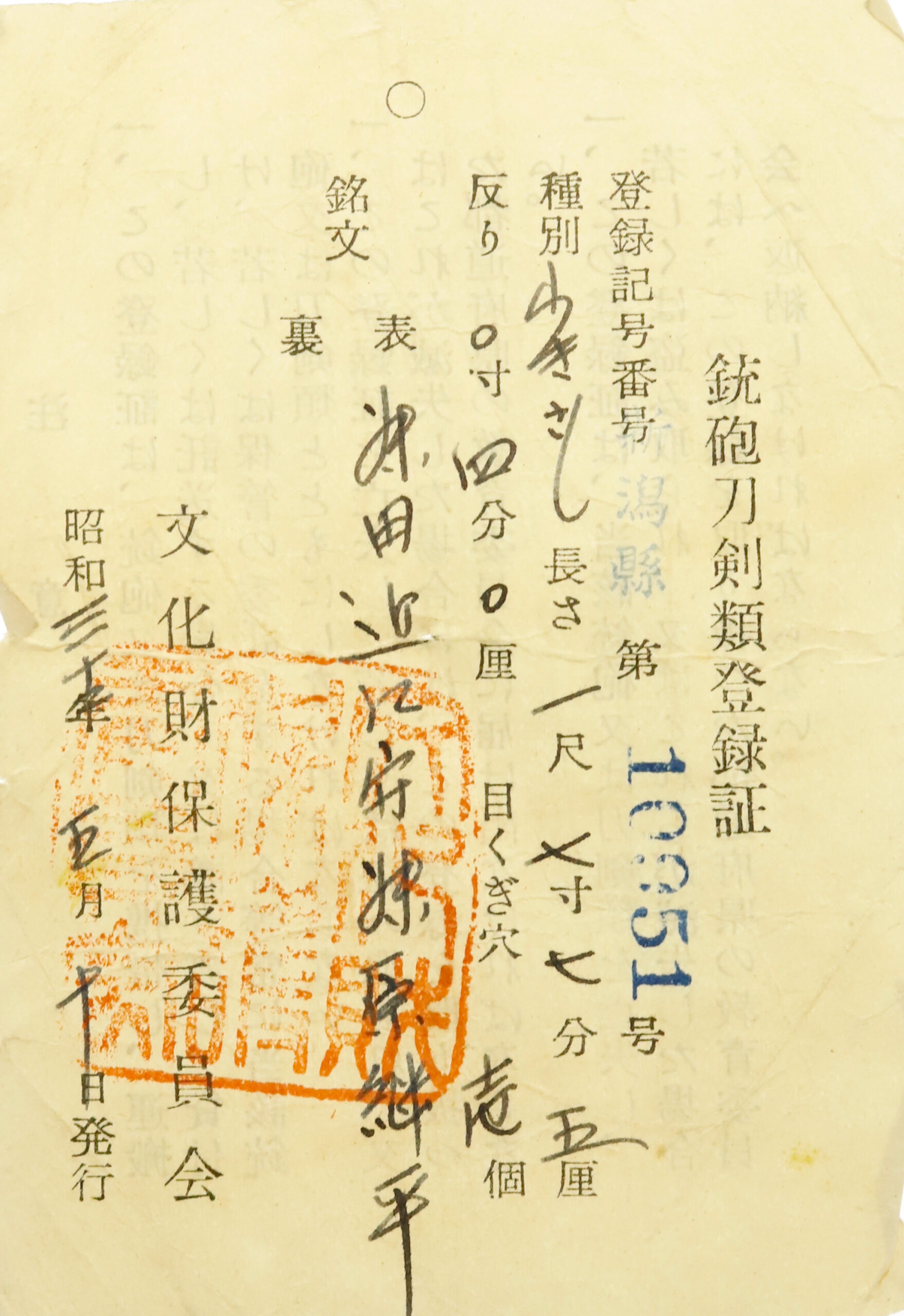
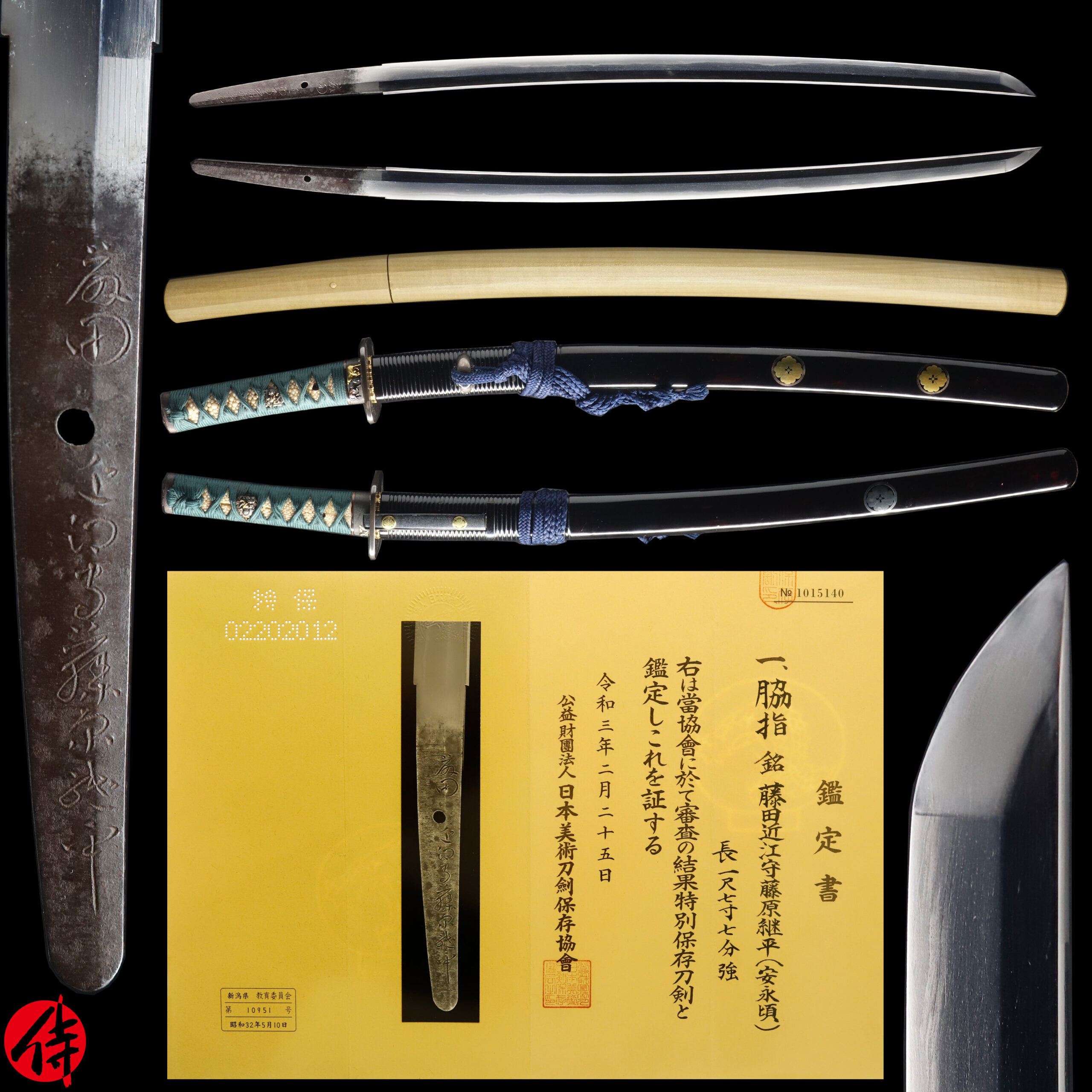
—————————————————————–
【About us】
Samurai Museum is located in Tokyo, Japan, exhibiting antique artifacts related to the Samurai history. Samurai Museum Shop is the place for those who are interested in Japanese culture and craftsmanship. We deal with antique Samurai swords/armor, traditional crafts made in Japan and so on.
【Japanese Sword& Export Process】
The Japanese swords we deal with are hand-forged edged swords made in Japan. It was made from the traditional carbon steel called TAMAHAGANE(玉鋼). Samurai Museum is familiar with the proper legal procedure for an antique/ authentic Japanese sword to be exported from Japan. We have sent more than 700 Japanese swords for the past few years (~2024) to amazing owners who appreciate its historical value.
Each Japanese sword is registered under the Agency for Cultural Affairs and the Board of Education in Japan. They issue a registration paper for each Japanese sword for its owner in Japan to legally possess it. The Japanese sword with its registration paper means it was traditionally hand-forged in Japan.
To legally export the sword from Japan to other countries, we will have to apply for its permit to the Agency for Cultural Affairs(Bunkacho) and return the original registration paper to the Board of Education. It normally takes around 2-4 weeks to receive this permit after submitting required documents. And we would like you to expect at least 1-1.5 months for your order to arrive at your given address after you ordered. For more detailed info, please click here.
It is allowed for residents in Japan to own authentic Japanese swords without a special license as long as they come with registration papers. Please feel free to contact us if you are a resident of Japan, whether temporarily or permanently. We will also assist you when you leave Japan and need to obtain the export permit.
【Payment Method】
We accept payment through Stripe (Credit card), PayPal, Apple Pay or ChromePay, all of which are secure payment methods. Also, you don’t need to make an account on Stripe for the checkout. If you prefer other payment method, please contact us. After confirming your payment, we will apply for an export permit. You may either pay in JPY, USD, AUD, CAD,EUR CHF or GBP. The price is set in Japanese Yen. Prices in other currencies are automatically calculated based on the latest exchange rate.

* If the amount is above 1 million JPY, Stripe or wire transfer will be the only options for payment.
【Shipping】
We have shipped authentic Japanese swords to the USA, UK, Canada, Mexico, Germany, France, Hong Kong, Finland and Australia. If you don’t live in these countries and like to order, please contact us first before making a purchase. We offer Free International Shipping as long as we can send antique Japanese swords by EMS.
We normally ship by EMS(Express Mail Service) provided by Japan Post. We will send you a tracking number for your order as soon as we hand it to the post office. We will put 100 % insurance on the shipping document without any extra charge. Based on the total amount, there might be a duty tax or other fee for you to pay, depending on the countries. We use package cushioning to protect the item and put it in a PVC pipe, which is one of the most secure packages because of its durability.
It will normally takes 5-14 days for the item to arrive at your given address after we dispatch it. Time of delivery is estimated as accurately as possible by the carrier but does not take into account any delays beyond our control such as by inclement weather, post office holiday seasons.
* If you live in Australia and like to purchase an authentic Japanese sword, please click here to know the detail.

【Review】
Here is one of the reviews we received from a customer who purchased an authentic Japanese sword from us. For more reviews, please click here.
“My experience overall with the whole process was wonderful. I had many questions about the history and process to purchase these treasures. All my questions were answered very timely and complete. The staff is very knowledgeable and very well versed if any questions do arise.”
【How to make sure the condition】
Please keep in mind that what you are going to purchase is an antique item. We uploaded high resolution photos for you to check its condition thoroughly. If you like to see more photos with different angles, please feel free to contact us. We will be happy to send them to you so that you can make informed decision. It is essential for us to know that you are happy with your choice of a sword. and we are prepared to use the best of our ability to serve you.
【How To Contact Us】
Please contact us through email, Facebook Messenger or Live Chat if you have any questions. You can find each icon on the right side of the website. Please click one of them to reach us. We will reply to you within 1-2 business days.
【The Art of Nihonto (Japanese Sword)】
Samurai’s history is a profound, eloquent legacy of ancient Japanese warriors in which millions of people worldwide are being fascinated. If you like to find out the art of Nihonto, please click here.
【A Guide to Japanese Sword Maintenance】
After acquiring an genuine Japanese sword, it is also important to know how to take good care of it. Here is the special video for you. Mr. Paul Martin, Japanese sword expert, shows you how to give proper maintenance to your sword. By mastering how to clean the Japanese sword, its aesthetic beauty will last forever.
When you purchase a Japanese sword from us, you can get a Free Japanese sword maintenance kit. It comes with four tools(Choji Oil, Uchiko Whetstone Powder, Peg remover, Oil Applicator). By watching the video instruction above , you can enjoy learning how to maintain your Japanese sword while appreciating it. If you have any difficulty assembling the sword or cleaning the blade, you can feel free to contact us.


MORE ANTIQUE JAPANESE SWORD FOR SALE
SWORDS WITHOUT CERTIFICATES FOR SALE
LEARN JAPANESE SWORD TERMINOLOGY
Thank you for reading all the information on the page. If you have any difficulty choosing the right Japanese sword for you, we will be more than happy to help you find the one that speaks to you the most. Please feel free to contact us.
